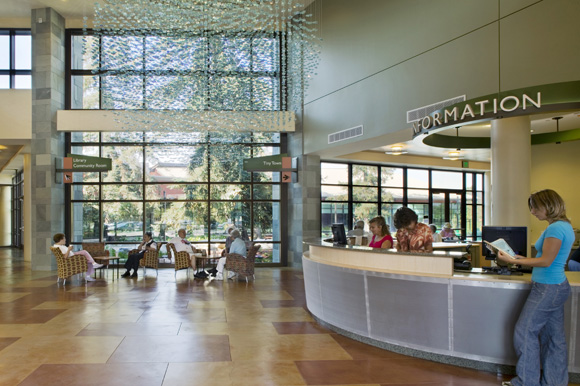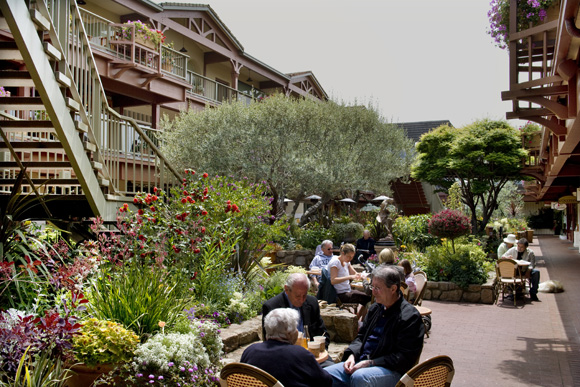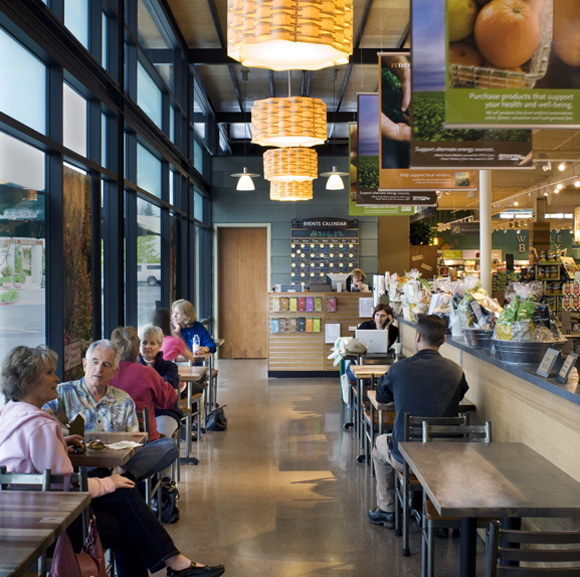We have not done a great job in America designing for the “senior surge” that has arrived as the baby boomers of the 1940s and ‘50s retire. Far too often, we expect our older population to enjoy segregated housing communities and dedicated senior centers. If they want to be “in the mix,” choices are hard to come by. If they live in the suburbs, a car is typically a requirement, and many seniors choose not to drive or cannot. For those who do, parking structures with complex circulation patterns are a barrier. In the inner city, dark nighttime streets, fear of crime, and an emphasis on speed all can be impediments to partaking fully in the urban lifestyle. There are models, however, that show how we can design both for access and for the choice to connect or not.
Retail Models
While retail architecture is not often looked to for inspiration, it is one setting where the age gap has been effectively closed. Shopping centers provide spaces that work together to make an entertaining and accessible destination. With many places to sit, wide walkways, good interior and exterior lighting, and visible security staff, seniors feel safe, comfortable, and part of the action. Since these are strolling environments, there is no urgency to get out of the way. Food, restrooms, and a movie are nearby.
As a result of the Americans with Disabilities Act, we have removed many barriers to access and institutionalized such physical improvements as sidewalk curb cuts, designated parking spaces, and accessible service counters, seating, and toilet rooms.
Retail management has gone further. Many large shopping centers provide a “mall walkers” program, an early-morning tradition in which seniors (and others) can meet, exercise in all seasons, grab coffee or a snack, and catch up on events. While not a direct source of income to many tenants, these programs benefit extended families and are a source of community goodwill.
In geographic areas with extended family populations, malls often serve as a gathering place, bringing generations together to share food and news. For example, the population in the vicinity of Otay Ranch Town Center in Chula Vista is about one-third Latino, with many families. To support traditional family gatherings, restaurants and shops cluster around large, outdoor, landscaped courtyards that feature fountains, fireplaces, low seating walls, benches, and chairs.
The similarity to the historic urban plaza is obvious; the difference is that you have to drive to the mall. To solve parking difficulties, some malls offer valet service. Nearby bus and transit routes are essential, as are well-marked, accessible pedestrian connections. The recent trend to locate a mixture of family and senior housing next to retail centers has the potential to integrate seniors more fully.
Community Centers
In more and more communities, the idea of constructing a designated senior center is falling by the wayside—and not just in response to the difficulty of passing bonds and obtaining public funding for single-use facilities. The city of Emeryville is planning a Center for Community Life to address the city’s lack of indoor and outdoor recreational facilities. A joint project of the city and the Emeryville Unified School District, the ambitious program will house the city’s K-12 schools on one site, across the street from the city’s preschool and near retail shops. The design includes a range of services for all ages. Those that particularly appeal to seniors include an adult school, a dance/fitness studio, an arts studio, a music studio, a multipurpose/performance space, an outdoor amphitheater, a gymnasium, and tennis courts. While parking is limited, the facility will be located along San Pablo Avenue, a major bus transit corridor. The city’s master plan calls for housing over retail on nearby sites, which would be ideal for seniors as well as the general population.
Some senior-only centers are expanding to include more generations. In Fullerton, the city plans to combine the Boys and Girls Club with the existing Senior Multi-Service Center. More often, traditional community centers are taking steps to ensure that seniors feel welcome, respected, and comfortable in multiple settings. The Almaden Library and Community Center in San Jose, which opened in 2006, combines full adult and children’s libraries with a senior meal program, a tiny tots program, a gymnasium, and fitness facilities. Seniors occupy lobby tables and chairs, enjoying the noise and commotion of people coming in and out of the front door, the gym, and the library entrance. Those seeking a quieter environment meet in a dedicated senior lounge on the second floor, where a commercial kitchen is used for cooking classes.

Branch Libraries
Predicted to have a sharp reduction in users with the growth of computer technology, libraries have surprised many of us with their surge in use. Taking a cue from newer bookstores, they have added new media, small cafés, self-checkout, a bestseller section, and comfortable chairs with views to the landscape.
But, like retail centers, they have gone further, creating special teen sections, where banquettes or oversized chairs allow three or four kids to cram together with their laptops. Separate homework rooms and tech learning rooms have doors that shut. For seniors, the benefits are many: they can learn how to use a computer for free in a supportive, dignified, and quiet setting—behind a closed door. They can check out the latest DVDs. In the adult section, they can doze in comfort among likeminded adults in front of a fireplace. They can watch the activities of their neighborhood in an environment that is accessible, well-lit, and accommodating.
Urban Design
Mobility is crucial for the aging population. Pedestrian-oriented environments with few stairs or grade changes, close to public transit, and with a mix of uses in close proximity, are ideal. Dense urban locations are great places for seniors, provided that security is in place and skateboarders are not. Low-cost dining choices, pocket parks, and shops that serve basic needs—drugstores, cleaners, and markets—make a livable mix. The value of a range of activities to offer visiting grandchildren cannot be overestimated.
Early streetcar suburbs worked for seniors. The Piedmont Avenue neighborhood of Oakland is a model. It grew as a suburb in the early 1900s along the Key Route electric streetcar line, and, although the streetcar is gone, buses still serve the area, which bears the imprint of its transit heritage. The street is pedestrian-friendly with a wide variety of uses, including a movie theater, restaurants, neighborhood-serving retail, and small plazas. For many, Kaiser Permanente’s nearby Oakland medical center is a valuable resource. Starting in the 1950s, a number of high-rise senior housing developments were built here. Without the neighborhood amenities, such high-rises could be bleak; with them, and with the connections to families, they feel more like home.
The Pearl District of Portland, Oregon, is a neighborhood well suited for all age groups. The municipality opened a light rail line through the former industrial district in 2001, helping stimulate redevelopment. Housing options range from rowhouses to rehabbed industrial warehouses to infill high-rises. Removing a concrete viaduct gave the area greater cohesiveness, and a network of open spaces, including Jamison Square and Tanner Springs Park, appeals to multiple generations.
Historic precedents are obvious. Consider the rich variety of small open spaces in Barrio Gotica in Barcelona, for example, where the community sorts itself out by age groups—older people occupying the few tables, the young lounging on the ground under a shade structure or straddling a long, low wall.

College Towns and Campuses
College towns also hold appeal for seniors, because they often offer high-quality medical institutions, well-landscaped walking environments, good public transit, and a vibrant community of young people. University-linked retirement communities on or near campuses are on the increase, built by private developers, academic institutions, or partnerships between the two. In most cases, residents have access to university amenities, such as the ability to attend classes and cultural and athletic events and to use libraries and recreational and dining facilities. Universities benefit by attracting potential donors with good memories of their college years. Some of these new residents serve as student mentors and campus volunteers.
At least fifty university-linked retirement communities operate in the United States, at institutions such as UC Davis, University of Michigan, Penn State, and University of Florida. The University of Southern California is considering a retirement community as part of a mixed-use development intended to include housing for staff. San Francisco State University recently purchased adjacent housing towers and apartments that it is making available to alumni, with easy access to the nearby Stonestown Mall, the West Portal neighborhood, and a major streetcar line.
Places to Connect
All these settings illustrate that contemporary architecture and urban design need to provide opportunities for all ages to connect and feel like they belong. On the same day, seniors may opt for segregated spaces and then choose to be in the mix, quietly observing or actively participating in community life. What makes the broad concept of community possible is this choice to connect or not. Our job is to find ways to make different kinds of connection a viable option for everybody.
Author Avery Taylor Moore, AIA, LEED AP, is a principal with Field Paoli in San Francisco. She is currently directing work for campus buildings, public libraries and sustainable workplaces.
Originally published 2nd quarter 2009, in arcCA 09.2, “Design for Aging.”






